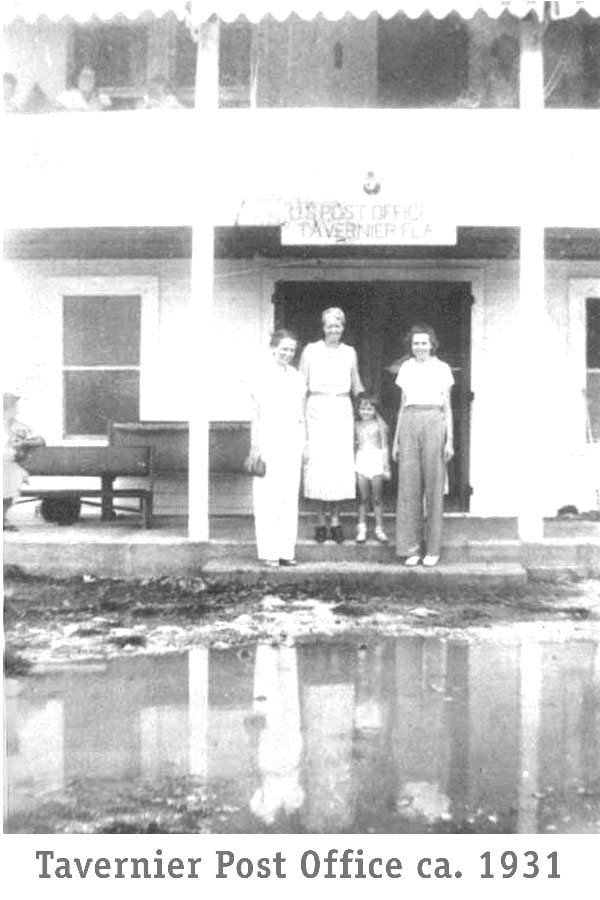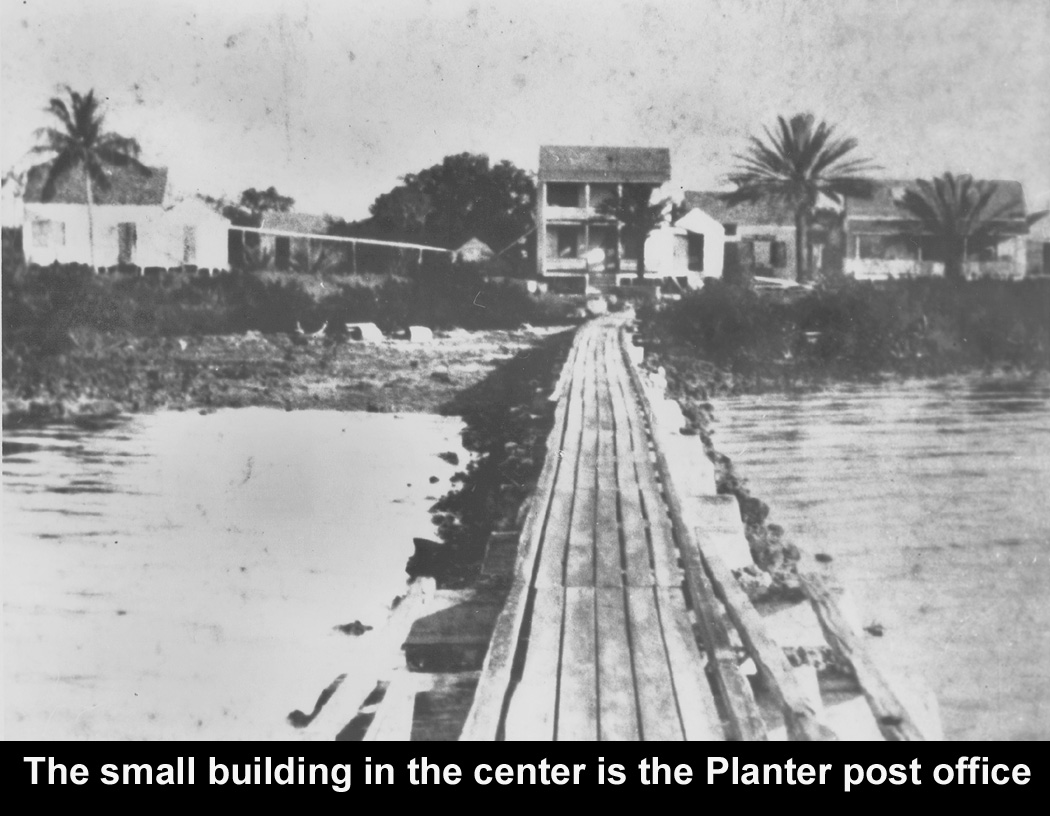|
HISTORY
OF
by Jerry Wilkinson |
 |
|
HISTORY
OF
by Jerry Wilkinson |
 |
The passage of the 1862 Federal Homestead Act and the surveying of the
Upper Keys in the early 1870s made a lot of land available for public
ownership.
In 1865, William and Robert Albury left the Bahamas for the mainland
and
settled near the site of Planter across the water gap from Tavernier
Island.
Records indicate that "In 1875, a storm-battered sailing ship reached
Tavernier
Harbor carrying Amos Lowe." The Sam Johnson family followed shortly to
settle northeast of the Albury's. Therefore, the southern end of Key
Largo
was spotted with three sizable families: Alburys, Lowes and Johnsons
all
living in a community eventually named Planter. See photo to the right.
The photo would be about 1895, maybe 1900.
There were no municipalities other than Key West; therefore, no finite city limit lines. Generally the post office name was the community name, but other names also existed. Most communities also has a center, even if it is just a gasoline station. Planter had the post office, a small store, and the community dock. The school and church was located more centrally of the population. Research reveals that the very southern oceanside tip of Key Largo was also known as "Lowe's Place or Lowe's Point." At the ocean end of Lowe Street would have been the Amos and Ada Lowe house on their June 1880 homestead. Son, Leonard, and grandson, Eugene, carried the Lowe tradition for decades. The "Albury's Place," was a just north and in between Lowe's and Johnson's homesteads. John Wesley Johnson established the Planter post office December 31, 1891 - the Johnsons were pineapple farmers-; therefore, the entire area was generically known as Planter. A note in passing is that all of southern Key Largo was known as Planter until the railroad came and the Planter post office closed and the Tavernier post office opened - 1911. My oldest railroad timetable is dated January 4, 1910 but I assume that at the time of the 1908 railroad opening the station name was Tavernier, but mail continued to be addressed to Planter until 1911. Using the railroad as a time frame, an unmarked newspaper article in the Flagler museum dated April 6, 1907 states, "The trestle has been completed over Tavernier Creek, Snake Creek and Umbrella Creek, while a large force of men are now engaged in finishing the trestle over Wilson's Key Channel (today Whale Harbor), which will give a trestle connection with Upper Matecumbe Key." Printing and distribution of the railroad time tables began in 1908 and became widely circulated. Still it took time for the use of the name Tavernier to replace that of Planter. The hurricane of 1909 hastened the demise of Planter. A pineapple blight also occurred and in October 1910 the Planter Post office closed, but Daniel Riley opened a Tavernier post office on March 9, 1911. Also alleged is when the railroad was completed to Key West in 1912, the importing of less expensive pineapples from Cuba destroyed the pineapple economy for Planter. With mail and primary transportation by way of the railroad, Planter's pier was no longer needed. When Planter's residents moved to Tavernier. Rodney Albury took his house from the Planter peninsular with him to Tavernier via a barge.
Other families moved in along with the pioneering Johnsons, Alburys and
Lowes. One was Marvin Thompson and his brothers, who came up from Key
West
around 1919. Marvin went on to develop the Palma Sola subdivision at
Planter
and was appointed justice of the peace in 1927. Other examples were O.
M. Woods, H. S. McKenzie, Cliff Carpenter and Harry Harris who moved in
the late 1920s. Others like the Wilkinsons and Allens came in the 1930s
followed by the Killingsworths in the 1940s.
The Planter community center to its east was by then almost a ghost town, as it's population had moved closer to the railroad in Tavernier. McKenzie was an enterprising person. Buying out the interests of Wood's, he practically built the Tavernier that developed around the railroad depot. Along with the bulk storage tanks, he also built a gas station, an ice house, tavern store, drug store, grocery store, hardware store, auto repair garage, lumber company and theater. The theater was not a success, so it was converted to a hotel.
Behind his drug store, which is now the Copper Kettle Restaurant, he,
in
conjunction with Florida Power and Light (FP&L), put in a
50-horsepower
diesel generator and installed electric lines to those homes who would
choose his service.
The Florida Keys Weekly News announced, "The Upper Keys Chamber
of Commerce was officially organized Thursday, May 29,1947. Officers
for
the year were elected as follows: President, Mr. McKenzie; Vice
President
Alonzo Cothron; Secretary, F.A. Calhoun; and Treasurer, Mr. McRae. The
first thing on their program is starting a summer Fishing Tournament
for
the Upper Keys." The Rock Harbor school was closed in 1939 and Tavernier's was the only school site on Key Largo. It was located in a Works Progress Administration (WPA) constructed combination hurricane shelter and school built after the 1935 hurricane. After the school moved to Plantation Key in 1951, the building became the office for the Upper Keys' first full-time doctor and dentist. It is presently the Monroe County Health Department. In the 1940s, electric and water systems were installed for the Keys and Tavernier became the headquarters for these activities. Harry Harris and "Mac" McKenzie owned most of the property in the center of Tavernier.
Harry Harris moved to Tavernier in 1931 after visiting his sister,
Mabel
Harris, who owned the restaurant "Mabels' Place" on upper Key Largo. He
began working for Mac and became the county commissioner in 1942
defeating
Roland Craig. (T. Jenkins Curry elected in 1938 living on Oceana Drive,
MM 103.5, was the first commissioner elected outside of Key West, Craig
of Craig Key elected in 1940 and Harris in 1942.) Before Harris really
got started, Uncle Sam drafted him in 1943 and the governor relieved
him
of office. Harris was discharged in 1944 and he returned to his county
commissioner’s position. W.A. Parrish Sr. of Marathon defeated him in
1946,
but Harris was returned to office in 1948, a position he held for the
next
28 years. Tavernier has the oldest volunteer fire department other than Key West. In 1934 local businessmen known as "The Boosters Club" obtained a fire trailer from Key West. It was pumped by hand and towed behind Eugene Lowe’s Model A Ford pick-up truck. After WW II Doug Killingsworth, a trained Homestead fireman, purchased the grocery store and built a firehouse along its north side. Tavernier, Islamorada and Key Largo struggled with hand-me-down military surplus fire fighting equipment. The three communities held fund raising events to build fire stations and in 1957 all three communities received state-of-the-art fire engines.
In the 1940s the Turner Funeral Home of Homestead provided ambulance
service
to the Upper Keys. Soon, Mr. Turner decided to leave an older ambulance
in Tavernier provided the volunteer medics would man it. Charles Louis
Pellicer was one of the drivers. Branham bought out Turner and
continued
to proved ambulances.
Adrian Rollini was an international famous jazz musician and just how Rollini came about owning the Driftwood is not understood. Rollini was a child projedy and played almost all instruments; however, better know for the bass saxophone with "California Ramblers" and the xylophone everywhere. Because of his notoriety seaplanes occasionally bought his guests to the pier. He died in 1956 and the Driftwood slowly deteriorated until Hurricane Donna finished it off in 1960. It was on the right side (south) of Sunrise on the Atlantic and farther south than the image below.
As a mid-1900s indication of population density, we have a 1951 telephone directory. It is titled Marathon, Key Largo and Matecumbe, Fla. There are three 6 X 9-inch pages for the Upper Keys. The totals of private and business phone listings are: Long Key 2, Craig 2, Lower Matecumbe Key 4, Islamorada 87, Snake Creek 2, Windley Key 1, Plantation Key 6, Tavernier 83, Rock Harbor 26, Key Largo 15 and Garden Cove 1. Of course, not every family and business had a telephone.
In the late 1950s, Joe Burton dredged the old water front of Planter
into
the Burton Yacht Basin. Docks were constructed and royal palms were
planted.
A small restaurant at water's edge was operated by John the Dutchman.
Hurricane
Donna in 1960 destroyed the marina. In 1983, the Old Tavernier Town Association identified 59 structures on 75.8 acres for a proposed historic district in the National Register for Historic Places. The oldest house was the Rodney Albury house, which he had taken apart and moved by boat from Planter in 1919. This group was instrumental in preserving the 1928 Merlin Albury house and the 1936 Methodist Church building. Florida rejected the National Register proposal. Over protests from local citizens and a lawsuit, in 1988 US Homes Incorporated began construction of Planter's Pointe condos. After considerable objections and a reduction of the number of units to be constructed, the name was changed to the Ocean Pointe condos that wiped the last traces of the early community of Planter from the face of the earth. Old Tavernier struggles successfully to retain its legacy.
-----End----- |
